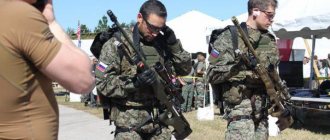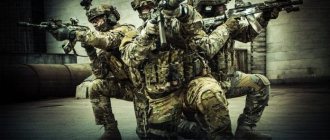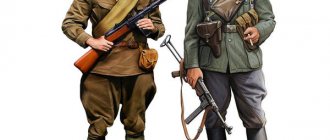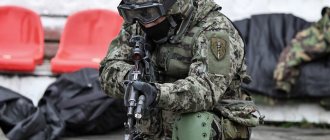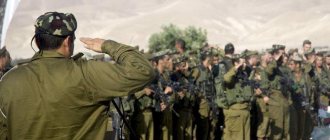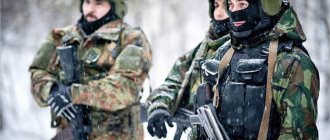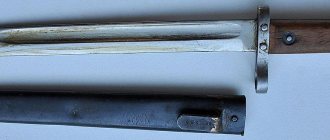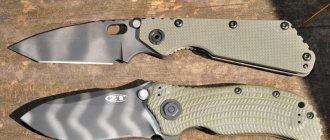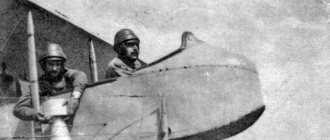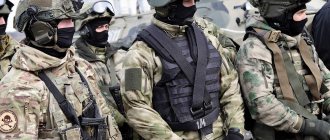The military cybermarket "Arsenal" presents accessories with FSB symbols, as well as uniforms, shoulder straps, stripes and souvenirs. The Federal Security Service is called upon to ensure the external and internal security of the Russian Federation, to fight terrorism, especially dangerous criminals and corrupt officials. Numerous units are staffed by military and civilian specialists; one of the department’s tasks is border activities. Since 1995, FSB officers have celebrated their professional holiday on December 20.
Story
The new FSB uniform is based on the uniforms of the People's Commissariat of Internal Affairs and the State Security Committee, but has certain differences.
The uniform of the NKVD officers was characterized by maximum authority, as evidenced by high quality materials. In addition, it was characterized by aesthetic elements in the form of gold and silver trim on uniforms and jackets, as well as metallic embroidery on sleeve insignia.
The uniform of the NKVD officers included:
- A blue wool cap with crimson piping and a maroon band, complemented by a metal five-pointed red star. Its distinctive features were a lacquered chin strap and a straight visor with a double, “Voroshilov” side.
- A light white cap with a red star, without piping. Her visor is made of thick woven fabric.
- The tunic has a protective color and is available in two versions. For winter uniforms - wool, and for summer uniforms - cotton. The cut of the product implied the presence of a turn-down collar with maroon buttonholes, an open vertical placket and breast pockets with buttons, as well as gold or silver lining of the collar and cuff.
- A white summer tunic made of cotton material, the cut of which was similar to the “protective” version of the tunic.
- Blue single-breasted open-cut jacket, decorated with three large buttons and maroon buttonholes. Depending on the rank, collars and cuffs were trimmed with soutache gold or silver. For the warm season, a white jacket of a similar cut was intended, but without edging.
- Trousers untucked or breeches tucked into boots. Both products were produced in blue tones and were decorated with crimson trims.
- A loose-fitting raglan coat or raincoat with a turn-down collar, dark gray in color.
- A Finnish cap with light brown fur and a red metal star attached to the front of the item
- Cowhide boots decorated with chrome heads.
- Black leather boots.
The uniform of KGB officers was presented in three options - ceremonial and weekend, for everyday and field tasks.
The dress uniform uniform had a noble sea green color. Shoulder straps, depending on the rank, are silver or gold. The steel-gray overcoat was complemented by gold buttons.
The everyday variation included trousers, a jacket and an overcoat in a “khaki” color. The inserts on the clothes were made in a cornflower blue shade.
Uniforms for field purposes included a single-breasted "protective" jacket and trousers tucked into boots. A cap with a cockade was a mandatory element. An insulated jacket was intended for the cold season.
After the collapse of the Soviet Union, a new state security department, the FSB, was created to replace the KGB. The uniform of employees of this service was regulated by a decree of Boris Nikolaevich Yeltsin in 1994. The document contains a number of changes:
- the color scheme of all uniforms became olive;
- instead of heavy and impractical overcoats, more comfortable and lightweight coats made of wear-resistant materials appeared;
- An alternative to pretentious jackets was simplified jackets, characterized by a classic cut and strict shape.
Current changes in the new form of uniform for FSB officers are recorded in Order No. 413, which came into force in August 2010.
FSB dress uniform
Formal uniform includes coats, raincoats, tunics, ties and blue-black boots. The shirts are blue and white. The papakha and earflap hat are made of fur in gray shades. For off-season wear, a leather jacket with a removable fur collar is provided. White gloves complete the look.
FSB casual uniform
In the new everyday form, woolen caps can be either blue-black or light green-olive. Black wool trousers are complemented by piping or stripes, in light green or cornflower blue colors. Shirts, white and blue, are complemented by black ties. The gloves, unlike the ceremonial version, are black. Warm hats are made of gray fur. Low boots and boots are made of black leather.
In addition to FSB employees, the form described in this document applies to other units that were part of the State Security Committee - the federal security service, the foreign intelligence department and the special security service of strategically important facilities.
The decision on the above-mentioned design and color schemes was based on the appearance of the uniform of special units, which, even in pre-revolutionary times, were engaged in counter-terrorism and intelligence tasks.
An important difference between the dress uniform and the everyday one is the golden-colored wreaths, symmetrically located at the edge of the upper edges. There are also special places for placing medals, orders and other awards.
Gifts for FSB employees
In addition to uniforms and accessories for employees, the Arsenal cybermarket offers gifts and souvenirs with FSB symbols. Original and unusual things will help you to adequately congratulate a colleague, boss or subordinate on their professional holiday, February 23 and other significant dates. Gift ideas can be very different:
- small accessories with FSB symbols in the form of keychains, tokens, lighters, flash drives and other little things will be a pleasant surprise and will delight your colleagues. At the same time, strict and useful items emphasize belonging to the department and offer a large selection for every occasion;
- accessories for offices of FSB employees. Posters, table flags, decorative figurines and stands for stationery will complement the interior of any place - from the manager’s office to the desk of an ordinary employee;
- gifts with humor, for example, T-shirts with FSB symbols, amulets in the form of border guards, folding shot glasses, bottle shirts and uniforms, original flasks;
- neutral souvenirs that will be useful in any situation: mugs, thermal mugs, teaspoons, glasses, business card holders;
- expensive gifts and souvenirs with FSB symbols. These are table and wrist watches, sets of shot glasses, desk accessories made of natural wood, diaries, document folders and purses made of genuine leather.
In the Arsenal catalog you can choose gifts and accessories with FSB symbols not only for agency employees. Among the souvenir products, there is something to please the male half of the country on Defender of the Fatherland Day. Sets of checkers in the form of a matchbox, T-shirts with original inscriptions, flasks, lighters, goods with the symbols of the border troops.
Buyers from any region of Russia can buy the product they like. We offer various delivery methods: courier to the address you specified, pickup from order pick-up points, delivery by mail. Payment is accepted by bank cards, transfers, cash upon receipt of the order. Details about the product, its characteristics and availability can always be found by calling 8-800-100-97-23.
Uniform for special forces
A separate type of army clothing is the uniform for special forces, which are the elite of the Armed Forces.
Its important distinctive features:
- convenience;
- practicality;
- functionality.
All these properties are due to the careful selection of materials that can withstand critically high and low temperatures, gusty winds and precipitation.
Uniforms for special forces are made primarily from rip-stop fabric. Maximum durability of the products is ensured by cross-weaving high-strength threads. The material is characterized by lightness, fire resistance, wind and water resistance.
The special forces uniform was introduced in 2007. This is a joint development from the Valentin Yudashkin Fashion House and the Central Research Institute of the Garment Industry.
The camouflage clothing set is made of a combined fabric containing equal parts cotton and polyester. It includes:
- A jacket with two shoulder and chest pockets, as well as one internal one. Equipped with easy-to-remove and put on shoulder straps with a Velcro fastener. For convenience, a similar fastener is available on the pockets and cuffs.
- Trousers with two welt side pockets, two patch pockets on the back and sides, and a pocket for storing a personal badge. Studs at the bottom of the legs make it easier to put on the boots. There is a Velcro insert on the knees, which, in combination with the seal, plays an additional protective role.
- A belt inserted into the belt loops of trousers.
Seasons - equipment of special forces, FSB, border detachments.
For special forces troops performing specific tasks, a wide selection of universal uniforms is provided. The units are called upon to carry out combat missions while in a non-standard environment:
- In the mountains;
- Forest belts;
- Settlements;
- In the air.
These factors explain the variety of types of uniforms and the absence of insignia on them.
The first field uniforms of classified military units were altered by the soldiers themselves; from the most suitable ones for the given case, they were allowed to independently equip American or European special forces with comfortable clothing.
First approved samples
When Alpha was formed in 1974, they first thought about introducing a uniform form. The most convenient flight equipment turned out to be, consisting of blue overalls and suits for technical personnel.
During the deployment of troops to Afghanistan, which took place in 1979, the special forces field uniform, for the hot, specific climate, was borrowed from the troops of Congolese President Colonel Mobutu.
Officially, the “sand”, “jump suit” or “Mabuta”, became the equipment of “Alpha”, and later the formed “Vympel”.
A successful joke that circulated among special forces in Afghanistan reflected the actual situation: “Clothing uniform number eight - what we have is what we wear.”
The combat uniform was often replenished with trophies, which caused envy in other parts of the units. Only special forces could not wear the mandatory helmet and body armor for others.
“Lightweight” or “Mabuta” became the basis for the uniform of special forces. The popularity of the suit, consisting of a jacket and trousers of a simple cut, was due to:
- Functionality;
- Convenient location of pockets;
- Perfect ventilation system;
- Using thin, durable Uzbek cotton fabric.
The summer set of clothes was complemented by a Panama hat with wide brims and ventilation holes, and yuft boots, which ensured long treks through mountainous terrain. Standard field boots and boots did not withstand use in harsh conditions; they wore out 2-3 pairs per year.
A winter version of equipment was also provided, taking into account the significant temperature changes observed in the mountainous areas of Afghanistan.
Special forces and KGB units, for carrying out secret operations in the rear, were provided with options analogous to the field uniforms of NATO countries. Comfortable sand-colored suits (there were examples of orch color) quickly faded in hot climates and became almost white.
This equipment is still a symbol of the Afghan war and is associated with GRU special forces. Wearing such clothing indicated that the fighter belonged to the elite of the security forces.
The advantages of the suit include:
- Preservation of shape;
- Wear resistance;
- Ability to dry quickly.
“Mabuta” has earned the love and recognition of the entire military personnel, from soldier to officer, with its simplicity and reliability.
Field Suit Upgrade
In 1981, the uniform was modernized and Mabuta-2 began to be produced. The bottom of the trousers was made with elastic, there were knee pads, a hidden fastener, and synthetic inserts that provided ventilation.
The shade changed, green and cream color options began to be produced. The water-repellent impregnation of the material has disappeared.
The modern special forces uniform adopted in the Russian Federation is convenient and functional. The field version was developed taking into account the specifics of solving combat missions and participating in exercises. It helps fighters in the most difficult moments, high quality ensures comfort in the most adverse conditions.
The field version of the uniform is represented by the Morok , made of two-component fabric (cotton + nylon). Ensofil processing, the use of advanced technologies, made it possible to create a unique material with increased abrasion resistance. The suit is resistant to active exposure to ultraviolet radiation, indispensable in mountain, forest, and steppe areas.
Winter suit, its modernization
The mountain suit (“gorka”), adopted by special forces back in 1974 and developed for assault units, has also changed. It has proven itself well during combat operations in the DRA thanks to its unique characteristics:
- Strong;
- Reliable;
- Windproof;
- Protects against moisture.
By 1980, the equipment was replenished with a wool sweater and a mask, and was sent for testing to secret units and operational groups of border troops.
Modern modifications of the mountain suit are divided into:
- Summer;
- Winter;
- Demi-season.
For harsh winters, the use of membrane fabrics is provided to protect against frost and winds.
Summer models are made of durable fabrics reminiscent of a tent.
Demi-season - have a light insulation lining with thermoregulating properties. Resistance to wetting is ensured by a special thread twisting technology.
In a number of models, instead of the usual jacket, there is an anorak worn over the head, which has an additional pocket for storing documents and cards.
The industry produces a variety of color variations: olive, birch, khaki, fog, digital, black.
Today, the “slide” is used not only by specialized troops, but also by climbers, tourists, hunters, and extreme sports enthusiasts, thanks to its successful cut and functionality:
- Camouflage properties;
- Comfort in any weather;
- Can be adjusted to suit any body type;
- Strengthening individual areas prone to deformation;
- The presence of a hood with a visor and adjustment.
Modern equipment provides comfort during high physical activity, resistance to mechanical stress, and protection when performing complex tasks.
Form requirements
Strict requirements are imposed on the uniform of FSB units:
- comfort while wearing, no difficulty or restriction of movements;
- adherence to a strict general style of all elements;
- symmetrical arrangement of stripes on each side;
- materials for uniforms for the autumn-winter period - light, warm, moisture-proof and highly breathable;
- materials for summer uniforms are lightweight, breathable, breathable, and adapt well to high temperatures.
